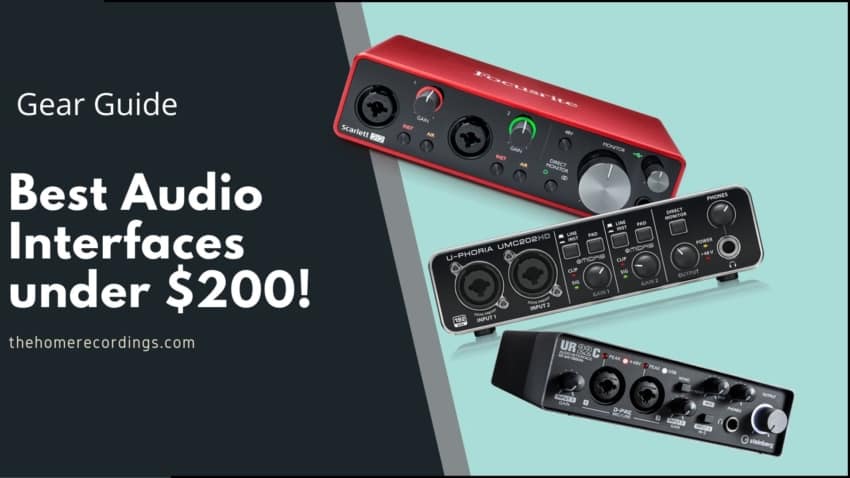Last updated on December 30th, 2023 at 02:45 pm
Today I’m going to be listing the Audio Interfaces that I think are the best ones for less than $200, I will go over their features, recording quality, included software, and at the end I will leave you with my top choices, since I think that there are a couple of the interfaces on this list that really stand out.
But first, here’s a table with as much relevant information about these interfaces as possible.
| Audio Interface | Features | Added Functionality | Free Software | Nr. of Inputs | MIDI I/O |
|---|---|---|---|---|---|
| Audient iD4 MKII | Best Preamps & Audio Quality. | iD Button for controlling DAW and Plugin parameters. | ARC Software Suite (Free DAW, Plugins, Wall of Sound cab sim, and Courses). | 1x XLR/TRS 1x D.I. (Instrument) | No |
| Focusrite Scarlett 2i2 3rd Gen | Reliable , “Air” Circuit for added brightness. | – | Free DAWs, Focusrite Creative Pack, Red 2 & 3 Plugin suites. | 2x XLR/TRS (Mic/line, Instrument) | No |
| Behringer U-Phoria UMC202HD | PAD. | – | Free DAW, 150 included instruments and effects. | 2x XLR/TRS (Mic/line, Instrument) | No |
| Behringer U-Phoria UMC404HD | PAD. Mono/Stereo switch. Monitor A/B testing switch. | – | – | 4x XLR/TRS (Mic/line, Instrument) | Yes |
| Steinberg UR22C | 32-bit/192kHz audio resolution. Stereo/Mono Switch. | DPS Chip for zero-latency processing (Great for recording guitar with amp sim) | dspMixFx software, Free DAW | 1x XLR/TRS (Mic/line) 1x XLR/TRS (Mic/Line, Instrument) | Yes |
| Komplete Audio Interfaces | – | – | Free DAW, Maschine Essentials, Effects & Instruments. | 1x XLR, 1x TRS. 2x XLR/TRS. 2x XLR/TRS and 2x TRS on the back. | Only on the Komplete Audio 6 |
| Presonus Studio 24c | – | – | Free DAW, Studio Magic Plugin Suite. | 2x XLR/TRS (Mic/line, Instrument) | Yes |
| Tascam US-2x2HR | Latency of up to 4 samples. | – | Free DAW, 3 months of Auto-Tune unlimited, 30GB worth of samples. | 2x XLR/TRS (Mic/line, Instrument) | Yes |
| Mackie Onyx Producer 2-2 | – | – | Free DAW and 23 plugins. | 2x XLR/TRS (Mic/line, Instrument) | Yes |
Now, without any further ado, let’s get into the list!
Audient iD4 MKII
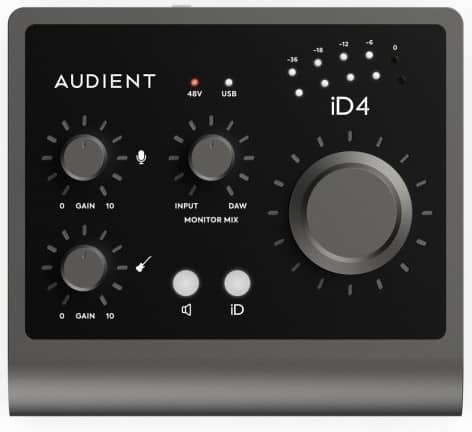
The Audient iD4 is a 2-input audio interface (1 XLR/TRS and 1 D.I.) that features one of the best-sounding D.I. inputs I have ever had the pleasure of using, plus the preamp inside of this interface is the exact same one used in the High-end Audient mixing boards, which sound extremely clear and warm and provide a lot of headroom.
Sadly, the iD4 doesn’t feature an optical port to increase the channel count and if that’s something you’re after, then consider having a look at its bigger brother, the Audient iD14, instead.
One interesting feature about the iD4 is its “iD” button, which allows you to use the big knob to control certain parameters in the DAW itself instead of having to rely on the mouse, such as adjusting volume automations on the fly, adjusting a specific EQ band, etc.
Additional features include: Separate Gain control for both the XLR/TRS input as well as the JFET Instrument input, Zero Latency Monitoring knob which allows you to adjust how much of the computer’s playback vs how much of the direct signal you’re hearing, 48v phantom power, two TRS main outputs, and a ¼” TRS headphone output with another 3.5mm headphone out.
As far as the included software goes, it comes with the ARC Software Suite: Cubase/Cubasis LE, Two Notes wall of sound cab simulation, Waldorf and Gforce virtual instruments, access to Loopcloud’s sample library, and even three music production courses by Produce Like a Pro.
The Audient iD4 isn’t an audio interface that comes with a huge number of features but rather just covers the basics. However, the quality of this interface is higher than the one of most other interfaces currently available, including the ones on this list.
Find out more about the Audient iD4 here:
- Audient iD4: Amazon, Sweetwater.
Focusrite Scarlett 2i2 3rd Gen
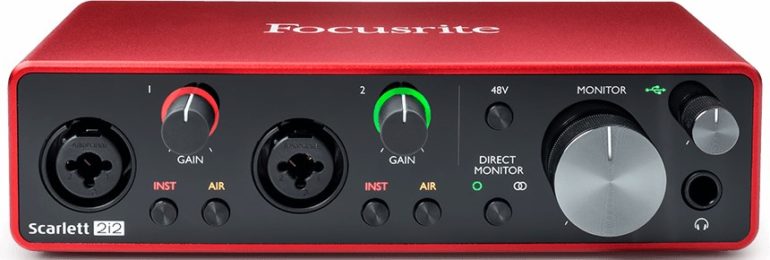
The Scarlett 2i2 3rd gen is by far the most recommended interface currently available due to its cost-to-performance ratio and because of how reliable it is.
It’s a two-channel audio interface featuring two XLR/TRS inputs that are capable of recording microphones as well as Line- and instrument level signals, and it also comes with two TRS ¼” main outputs and one headphone out.
What sets this interface apart from the other ones on this list is that it offers the “Air” feature which is an emulation of Focusrite’s iconic ISA mic preamp and that when engaged brightens up the sound, making it sound more open.
In addition to all of this, the 2i2 offers latency free monitoring and 48v phantom power, and even a couple free downloadable software options, such as Ableton Live Lite, Pro Tools First Focusrite Creative Pack, the Focusrite Red 2 and 3 plugin suites, and much more.
The Focusrite Scarlett 2i2 is a great entry-level interface since it features great sound quality, two inputs and a lot of free plugins as well as other additional software.
Find out more about the Scarlett 2i2 3rd Gen here:
- Scarlett 2i2 3rd Gen: Amazon, Sweetwater.
Behringer UMC202HD
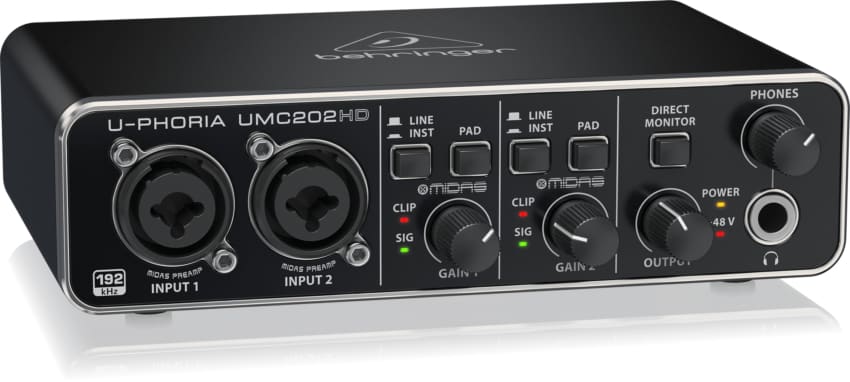
The UMC202HD in an entry-level audio interface that comes with the MIDAS designed mic-preamps which give you the same sound quality as their popular mixers, but at an affordable price and in a much more portable form.
As far as the inputs go, it has two Combi- XLR and ¼” inputs on the front capable of recording two Microphones or Line/Instrument level signals through USB directly into your DAW at a maximum sample rate of 192kHz and a bit depth of 24-bit, and it can also provide your condenser mics with 48v phantom power which can be enabled from the back.
It also has the Direct Monitoring function which can be enabled by tapping on the “Direct Monitoring” switch, which is really useful while recording since you don’t want to have the sound being sent into the PC, processed and then sent back out to your headphones since this will introduce unnecessary latency.
As far as the outputs go, it only offers two ¼” TRS jacks on the back and another ¼” TRS jack for the headphones on the front.
Each channel comes with the essential controls that you could need; there’s the gain control for each individual input, an attenuation pad, a switch that lets you choose between line and instrument level, plus the general output controls such “Output” and “Headphone” volume.
The UMC202HD generally gets compared to the Scarlett 2i2 because it’s a very similar interface that even offers a PAD, which the 2i2 doesn’t, and that sells for nearly half the price, making it a very cost-efficient interface.
Find out more about the Behringer U-Phoria UMC204HD here:
- Behringer UMC202HD: Amazon, Sweetwater.
Behringer UMC404HD
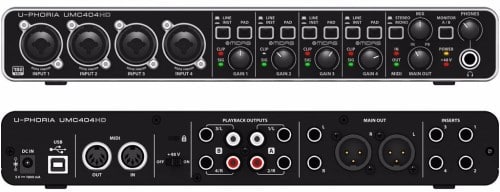
The UMC404HD is probably the best interface for any beginner that is on a budget since it features 4 XLR/TRS inputs with Behringer’s MIDAS preamps, MIDI I/O, and even TRS and RCA playback outputs with an A/B switch that allows you to playback through a different set of speakers, and all of this for around $150.
Each of the four inputs also lets you choose between mic/line- and instrument level and they even feature a PAD for when you’re recording really loud sources.
The A/B monitoring function can really come in handy for when you want to listen to a mix on a different set of monitors or on a Hi-Fi stereo system, and what’s more is that the UMC404HD also comes with a Mono/Stereo switch, which might not seem like much but most DAWs don’t have a really simple way of letting you listen to the mix in mono, so this feature truly does come in handy.
MIDI I/O can be found on the back of the UCM404HD, and even though you could certainly connect your MIDI keyboard via USB, there are some advantages to using the interface (usually lower latency).
Another interesting feature are the 4 Inserts on the back that can be used to add external effects to the chain.
The UMC404HD is by far my top recommendation for any beginner who needs more than two inputs and who is on a budget since not only does it sound great, but it packs a lot more features than any other interface in this price range.
Find out more about the Behringer U-Phoria UMC404HD here:
- Behringer U-Phoria UMC404HD: Amazon, Sweetwater.
Steinberg UR22c
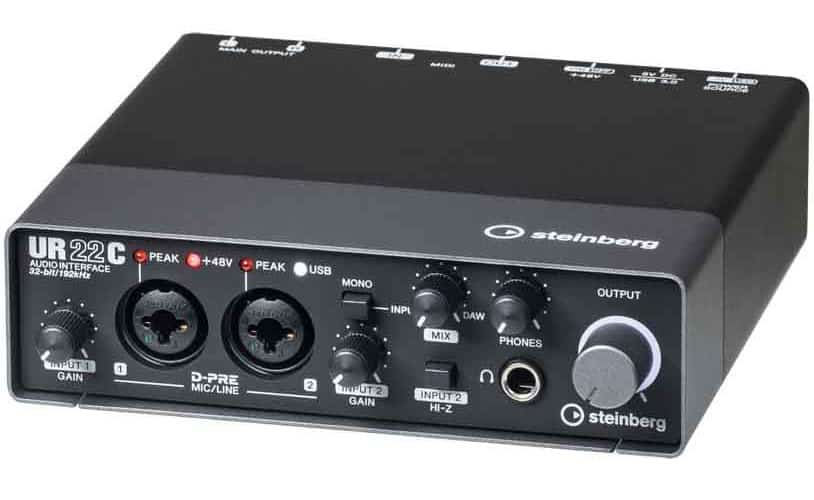
The UR22c is a 2×2 USB audio interface that features the D-Pre preamps and a whopping 32-bit/192kHz audio resolution, which is way higher than the standard 16-bit/44.1kHz that’s generally used to record music.
Input 1 is only designed to handle Mic and Line level signals while the second input can also be used to record Hi-Z Instruments, such as guitar and bass.
However, what really sets this audio interface apart from all the other ones on this list is that it features a built-in DPS chip that can be used for zero-latency monitoring while still using effects, and this is done via the dspMixFx software, which also comes included.
The effects included with the dspMixFx software are the REV-X Reverb, the Sweet Spot Morphing Channel Strip, and the Guitar Amp Classics bundle (Clean, Crunch, Drive and Lead Amps included), which allows you to record guitar using those Guitar amp sims without any latency and without taxing your CPU.
Other than that, the UR22C offers 48v phantom power, a “Mono” switch that lets you hear to your mix in mono, MIDI I/O, a “Mix” knob that lets you choose how much of your PC’s playback vs how much of the direct signal you’re hearing, two ¼” TRS outputs as well as a headphone out, and a copy of Cubase AI and Cubasis LE (for iPad).
Out of all the audio interfaces on this list, I think that the UR22C is the best one for guitar players because of the built-in DSP chip and the included amp sims, since this lets you record guitar latency-free.
Find out more about the Steinberg UR22C here:
- Steinberg UR22C: Amazon, Sweetwater.
Komplete Audio Series
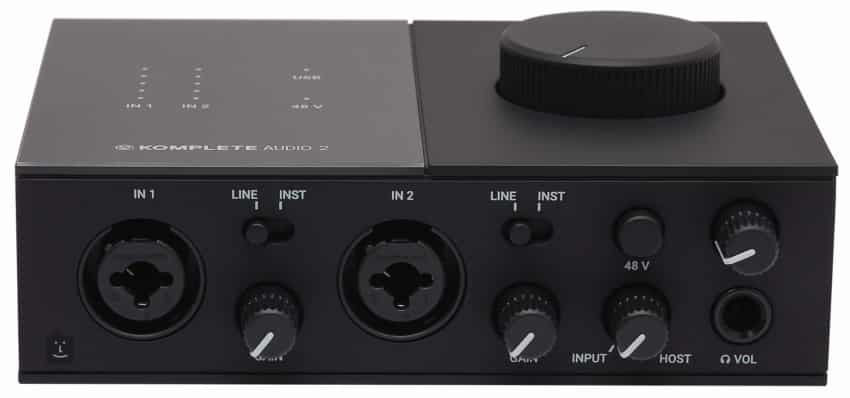
The Komplete Audio Series Interfaces by Native instruments are comprised of 1-input, 2-input and 4-input devices, the Komplete Audio 1, 2 and 6 respectively.
The smallest one of the three, the Komplete Audio 1, features 1 XLR input and another TRS input with switchable Line/Instrument level, and both of these inputs can be recorded independently, and on the back it’s got RCA outputs.
The Komplete Audio 2 is almost identical, with the only differences being that it features two XLR/TRS inputs with switchable Line/Instrument level for both, and TRS outputs on the back instead of RCA.
Both the Komplete Audio 1 and 2 offer one headphone output, 48v phantom power and zero-latency monitoring.
The bigger of the three, the Komplete Audio 6, costs slightly more than $200 but it does come with a lot of extras, such as 2 more TRS inputs on the back, MIDI I/O, S/PDIF, two headphone outputs, and four main outputs, and it also features everything the other two do.
What makes these interfaces stand out is the huge number of free plugins & software you get when you purchase one, such as Ableton Live Lite, Maschine Essentials (Instruments, effects and sounds), Studio-grade effects, and more.
It’s worth noting, however, that the Komplete Audio 6 includes a couple additional downloads that the other two don’t, such as Trakton LE 3.
The Komplete Audio series are a good choice for anyone who is in need of an audio interface that comes packed with all of the essential software to get you started with recording, mixing, and music production in general.
Find out more about the Komplete Audio Interfaces here here.
- Komplete Audio 6 MK2: Amazon, Sweetwater.
- Komplete Audio 2: Amazon, Sweetwater.
- Komplete Audio 1: Amazon, Sweetwater.
PreSonus Studio 24c
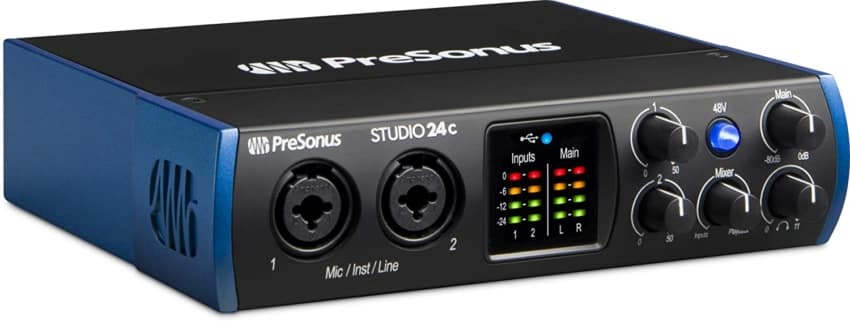
The Studio 24C is a 2×2 audio interface that features Presonus’s XMAX-L Preamps and a recording resolution of up to 24-bit/192kHz. Both of the inputs allow for Mic, Line and Instrument level signals, and 48v phantom power can be supplied to those inputs if needed.
Just like most modern audio interfaces, the Studio 24c allows for Zero-latency monitoring, and it also offers MIDI I/O.
However, what makes this interface stand out from the rest is the included software, since not only are you getting Studio One Artist edition, which is Presonus’s own DAW that works amazingly well, but it also features the Studio Magic Plugin suite, which includes the Lexicon MPX-I Reverb, the SPL Attacker Plus, the UVI Model D (Concert Piano), the Brainworx bx_opto compressor, Ableton Live Lite, and much more.
While the Presonus Studio 24c might not offer onboard DSP, or any other fancy features for that matter, the included software could certainly help you get started since it covers most of what you need to produce a song from start to finish.
Find out more about the Presonus Studio 24c here:
- Presonus Studio 24c: Amazon, Sweetwater.
TASCAM US-2x2HR
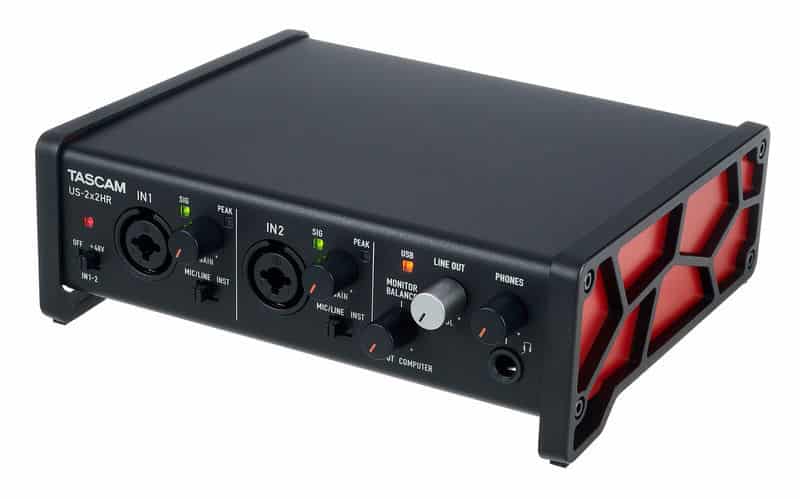
The Tascam US-2x2HR has 2 combi- XLR/TRS inputs featuring Tascam’s Ultra-HDDA preamps with assignable Mic/line and Instrument level, MIDI I/O, and a recording resolution of up to 24-bit/192kHz.
As far as outputs go, it offers two TRS balanced outputs on the back and a headphone output on the front.
One interesting feature is that with its newly released drivers, the Tascam US-2x2HR can give you latency of as low as 4 samples (I generally record using 16 or 32 samples and that puts me around the 3ms mark).
Similar to the previous interface on this list, the UX-2x2HR comes with a huge software bundle included, such as Cubase LE, Cubasis LE (iOS), a three-month subscription to Auto-Tune unlimited, and SampleTank SE (Over 2000 instruments in 30GB).
Out of all the interfaces on this list, I have to say that the Tascam US-2x2HR isn’t the one I’d recommend the most since there are others that either offer more built-in features, such as the Behringer UMC404HD, or that come with more included software (Presonus Studio 24C, Komplete Audio Series), or even like the Steinberg UR22C which features a built-in DSP.
Still, the UX-2x2HR is a great entry-level interface that comes with the highest number of instruments and samples I’ve seen in a long time.
Find out more about the Tascam US-2x2HR here:
- Tascam US-2x2HR: Amazon, Sweetwater.
Mackie Onyx Producer 2-2
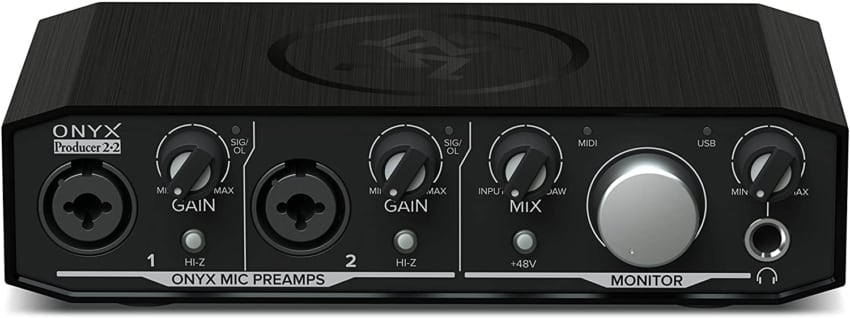
The Producer 2-2 audio interface offers two combi- XLR/TRS inputs for connecting microphones and Line/instrument level sources, it features the Onyx Audio preamps and can record at an audio resolution of up to 24-bit/192kHz.
In addition to this, the Producer 2-2 offers MIDI I/O, 2x ¼” Main outputs, zero-latency monitoring, 48v phantom power, and a headphone jack with independent volume control.
The reason I included this interface on this list is mainly because of all the included software, especially if you want to learn how to mix using premium-quality plugins.
Here’s the free software that comes included:
The Waveform DAW and Pro Tools First, as well as a total of 23 high-quality plugins, from EQ and compression, to reverb, delay, Tuning, Overdrive, Chorus, and many more.
This bundle doesn’t come with loads of samples or VST instruments that you can use with your MIDI keyboard, but it does provide you with all the necessary tools to learn to edit and mix audio.
Find out more about the Mackie Onyx Producer 2-2 here:
- Mackie Onyx Producer 2-2: Amazon, Sweetwater.
Honorable Mentions
Behringer UMC22
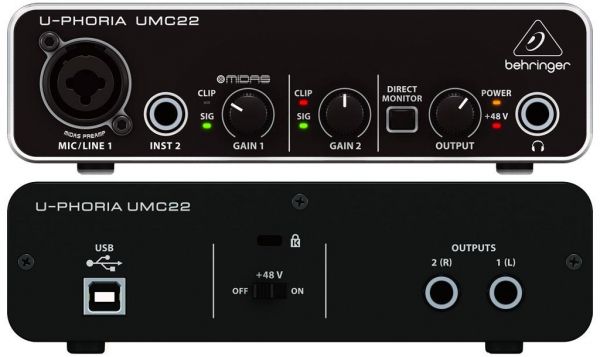
The UMC22 is an entry-level audio interface meant for beginner musicians and producers who are on a very limited budget. It features one XLR/TRS input and another ¼” instrument jack which can be recorded interdependently from each other.
Aside from that it only offers direct monitoring and phantom power as well as two ¼” outputs on the back, but that’s about it!
Find out more about the Behringer U-Phoria UMC22 here:
- Behringer U-Phoria UMC22: Amazon, Sweetwater.
M-Audio M-Track Solo & Duo
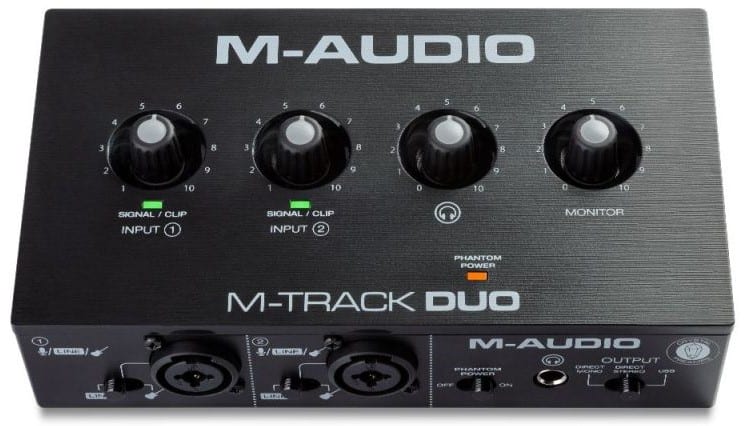
Similar to the UMC22, both the M-Audio M-Track Solo and Duo are entry level interfaces aimed at absolute beginners who are on a tight budget since they sell for well under $100.
The Solo features an XLR/TRS Input as well as one instrument input, while the Duo offers two XLR/TRS inputs both with assignable Mic/line and Instrument level.
Zero-latency monitoring, 48v phantom power, headphone outputs (3.5mm for the Solo and ¼” for the duo), as well as main outputs (RCA for the Solo and 1/$” TRS for the Duo) are also available.
With both of these interfaces you get access to Pro Tools First, MPC Beats, and the AIR Music Tech Xpand.
Considering the extremely low price of these interfaces and the free software you get, they definitely are a great choice for beginners.
Find out more about the M-Audio M-Track Interfaces here:
- M-Audio M-Track Solo: Amazon, Sweetwater.
- M-Audio M-Track Duo: Amazon, Sweetwater.
My Top Choices
Even though all of the audio interfaces on this list will let you produce great music, I think that there are four that really stand out, and these are:
- Audient iD4
- Behringer UMC404HD
- Steinberg UR22c
- Focusrite Scarlett 2i2
Now, what makes these interfaces better than the rest?
As far as the Audient iD4 goes, it’s got the best sound quality and the JFET D.I. is fantastic for recording guitar and bass. Of course, it’s a premium product since it only offers 1 XLR/TRS input as well as the D.I. and doesn’t come with any extras, such as MIDI, S/PDIF, etc.
I would only recommend getting the Audient if you truly want the best sound possible and can do without the additional features that other interfaces have to offer.
The Behringer UMC404HD would be my top recommendation for most users because it provides 4 XLR/TRS inputs (Instrument level switch on all four), MIDI I/O, Stereo/Mono switch, Monitor A/B switch, PAD, etc.
Essentially, it’s a feature-packed interface at a very affordable price (well below $200) and most beginner/intermediate musicians and producers will love the huge number of features.
The Steinberg UR22c would be my top recommendation if you are a guitar player since it offers the built-in DSP chip that lets you record using Steinberg’s amp sims latency free, plus you can also add reverb, delay, etc. to record your vocals.
Lastly, the Scarlett 2i2 is an absolute workhorse that sounds great and is very reliable, which is the primary reason that it’s so well rated everywhere.
If I had to choose, I’d either go with the Behringer UMC404HD or the Steinberg UR22c because of their built-in features.
What if you need more inputs?
Being able to record an entire band requires way more inputs than the ones the audio interfaces on this list can provide.
Here you have a couple options;
USB Mixers that can record multitracks: These are generally expensive but may allow you to record 20 tracks or more to your PC individually.
Larger Audio Interfaces: This one is fairly self-explanatory, but investing in an audio interface that has more inputs right from the start can save you money in the long run.
Audio Interfaces with ADAT/Optical Input: Some Audio Interfaces, like my Audient iD14, feature an optical input on the back that lets you connect external preamps to them, and each of those ports can carry up to 8 channels of 48kHz of audio.
So, if you have a 2-input interface that features such an optical input, you can essentially increase that number to 10 by getting an external preamp.
Conclusion
Like I just mentioned, I think that most beginners should go with the Behringer UMC404HD since the number of features it provides is just absurd for that price, and the audio quality is fantastic, in fact, most people won’t be able to tell the difference between audio that’s been recorded using the UCM404HD and even an Apollo Twin MKII ($900 interface).
All modern audio interfaces sound great and I believe that you should mainly focus on the features and utility that they might provide you with rather than “how good they sound”, since they all sound fantastic (Except the really cheap ones, like the Behringer UM2)!
Don’t let anyone tell you that you can’t produce high-quality music unless you spend $1000 on an interface since this really won’t do anything. High-end gear only makes sense in high-end studios, and that’s why I like the UMC404HD so much.
I hope this information was useful!
Have a great day!
